PROGRESS REPORT #7
December 6, 1999
Second Phase
Projects in Puerto Rico
The main purpose of the November
21st, 1999 trip to Puerto Rico was to do the
site survey and get the technical details needed to assemble,
test, and return to install reliable
wireless links between the three LTER
Weather Stations in the El Yunque Rainforest, the El Verde Research
Station, and the Internet.
However in each visit completing
previous tasks, we need to discern the outlines
of future tasks. So three projects which will probably be started
in the summer or fall of 2000 were
explored.
The Caribbean National Forest,
has facilities (Catelina, Sabena, and Visitor
Center) near the north edge of the El Yunque forest, and east
of El Verde, accessible by different
roads from the coastal highway Route #3.

BISLEY STREAM MEASUREMENTS
As described in Progress Report
6, Dr. Fred Scatena, a research hydrologist
for the U.S. National Forest Service, stationed in Puerto Rico,
(Institute of Tropical Forestry) pursues his own parallel studies
of the rainforest as a collaborative
part of the Luquillo Experimental Forest LTER.
One set of studies involve measuring rainforest streams, their
low rates, chemistry and other characteristics.
In the Bisley area, south of the
Sabena Forest Service work center, and close to Weather Station
#3 is one of his stream monitoring
stations.
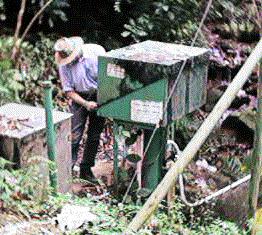
While we must delay attempting
to connect up this stream station at Bisley wirelessly
(it will be a real challenge being at the bottom of a ravine at
the bottom of the forest vegetation),
it is interesting because the sensory
equipment and the data logger from Sutron Corporation, of Virginia.
The Forest Service favors these sensors and dataloggers, even
though they are more expensive than
Campbell equipment. But since both products
are in wide usage, we will have the opportunity to interface to
Sutron data loggers as well as Campbell
- and report broader results.
The data is collected from this
sensor (Sutron 8210) set by means of a PCMIA
card that is in the logger, removed, and inserted into a PCMIA
card slot on a desk top computer
at Sabena Work Center, where a technical assistant
to Fred Scatena extracts the data. This Bisley stream site will
pose the most difficult wireless
challenge yet. We will have to do much experimentation
with different radios, spectrum analyzer, and perhaps different
approaches to reaching into the stream bed - perhaps by direct
paths from the top of Pico del Este
or Pico el Yunque which, if the angle of
penetration of the forest is high enough - from the 1000 foot
mountains to the 350 foot level -
may be able to get through the vegetation without another
relay.
At one time there was a satellite
feed from the Bisley Stream monitoring station
- and some of the ground equipment is still in place. It may be
that we have to resort to use of
a satellite rather than terrestrial link to
the Internet, and from it, thence back to El Verde, Sabena, and
the Center for Tropical Studies.
COMMUNICATING COQUI SOUNDS FROM EL TORO
PEAK
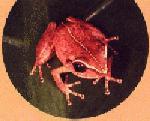
Not directly part of the NSF LTER
studies, but very much part of the overall
biological science studies of plant and animal life in the rainforest,
there is a Tree Frog Sample Monitoring of Catelina Project by
a National Forest research team headed
by Pedro Rios. This is all part of the Ecosystems
Management of the Caribbean National Forest. Dr. Victor Cuevas,
General Biologist is involved with
the specific monitoring of species of the
tony frogs popularly named 'Coqui' -of genus Eleutherodactylus.
There are 16 species in Puerto Rico,
and two of these are found on 1000 foot El Toro
Peak - Richmondi and Eneidaen.
The Coqui are best known for their
characteristic, surprisingly loud (even annoying
when they are in built-up areas) "Co-KEY" sounds they produce
at night. Those sounds, when recorded
and carefully tracked, give scientists useful
information about their location, density, and over time general
environmental and ecological health.
In particular there is an ongoing
research project recording the night sounds
of the Coqui subspecies on El Toro Peak. One species begins to
sing soon after dark, the other only
after midnight. In order to study these
sounds, researchers equipped with sound recording systems have
to depart after dark, climb for up
to 4 hours up an often muddy, risky, trail to
get near the top of El Toro by midnight, go into blinds, and record
the sounds for hours. It is tiring,
it is somewhat risky, and risks changes in the
weather, and is very labor intensive.
Victor Cuevas, in my meetings
with him, and his supervisor, suggested that it
would be outstanding if we could install wirelessly connected
(to the research center) microphones
during daylight, and capture the Coqui sounds without
the necessity of teams going up there in the dark.
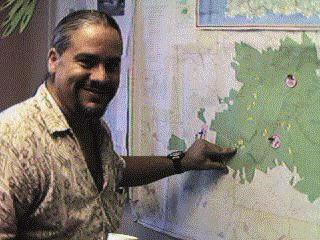
This is only one part of the larger
research reality, that monitoring forest
- bird and other - sounds is a help to forest research. In fact
the extremely important Puerto Rican
Parrot Recovery project, which involves the
Forest Service, Fish and Wildlife Service, and the Puerto Rican
Department of Natural Resources,
needs ways to record Parrot sounds. The Parrots
have just come back from near extinction over the past decades,
and intense, scientifically based,
management has been the key to their survival.
We MAY be able to become involved also in this project - especially
since it will exercise, not just sound, but real time video monitoring,
wirelessly transmitted to monitoring stations.
In our visit to Dr Cuevas at Catelina
Management Center, he showed us the equipment
currently being used to record the forest sounds. The Sony TCM-5000EV,
shown here was modified to better record the frequencies emitted
by birds. We will see if we can directly interface the microphone
to a device that will send the sounds
as IP packets over the wireless connections.
This also will be a challenge, less because of the wireless connections
- for the instruments will be on the top of El Toro Peak and will
have line of sight to many locations - but because of the sound
interface problems.
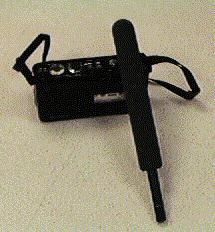
While those at the Catalina Forest
Management Center became very interested
when they realized from our explanations of what our Wireless
Technologies may be able to do, and
that we were funded to do experiments to
prove out and model wireless solutions, they expressed interest
in our becoming involved immediately
in the Parrot Recovery Project. We cannot, however
this first NSF Project year, do everything. It will have to be
a progressive process, learning what
it takes to communicate in and through the
rainforest, before we can handle the more exotic things.
However, one thing is clear -
when compared with the data rates that are customarily
used by the commercial data loggers, and even those systems from
companies like Campbell and Sutron which have been adapted to
the use of licensed VHF radio channels,
the data rates possible by current generations
of spread spectrum no license radios - from 115kbps to 11Mbps
will permit the interactive transmittal
of multimedia information, and data
from many sites, simultaneously.
LIGHT ON THE FOREST FLOOR at EL
VERDE
Dr. Jill Thompson, a researcher
at El Verde, has been working on the
problem of measuring light which reaches the forest floor through
the canopy in a 'recovering' rain
forest area.This is the kind of forest
that the sensors at ground level operate in.
Jess Zimmerman walking out the
trail from El Verde to one of the ground level
research plots in the 'recovering' (from Hurricane) rainforest.
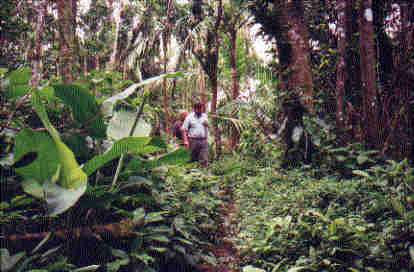
As described by Engineer Mike Willett who interviewed
Jill with me, at El Verde Research
Station, the problem can be expressed thusly:
"This project covers a plot of
ground to measure the ecological phenomenon in
an open area. This area was at one time fairly well forested,
but due to a hurricane or some other
event, the area is now without a great deal of
canopy. The researcher, Jill Thompson, measures the parameters
of the plot with several sensors
spread over a large area. This area is a grid pattern,
such as an equally spaced quad of sensors located at 5, 10, 15,
20 and 25 meters, etc., to cover
the desired observation / experimentation area.
The plots are large, and require
a great deal of wire to connect each sensor
to the data logger. Working with the wire appears to be more cumbersome
and troublesome than the cost. The physical dynamics of the area,
of which there are several plots of this type, become a logistics
and man power related problem.
The parameters measured are primarily
light, moisture and pH. We feel there
may be a very low cost solution to the problem by using very low
power radios and creating a simplistic
network of low cost, "smart" sensors.
These sensors could possibly talk via IP to one another, however,
it is likely a more simple method
would be used, and IP be reserved for the
central host.
Another problem faced by the researchers
seem to be the cost of a quality sensor.
All sensors have a limited life time, but the difference between
one sensor cost and another can be
as much as 600%. We will experiment in this
area as well, trying to encapsulate a low cost sensor in a high
quality glass tube to alleviate the
effects of ultraviolet radiation clouding
the sensor's epoxy coating."
The plots which Dr Thompson now
monitor, exchanging data with Dr. Ned Fetcher
of the University of Scranton in Pennsylvania, are just north
of the El Verde Research Station.
Dr. Fetcher, in a previous visit, was extremely
interested in the potential presented by our wireless solutions
connected to the Internet, to be
able, real time, to observe the data from the
plots tended by Jill Thompson.
The sketch map below shows the
range of experiments in the Research Areas close
to the El Verde Field Station, including the areas in which the
four plots measuring light reside.
In later Progress Reports we will annotate this
map more usefully - but at this time we do not know all the experiments
going on, only some of which will involve our wireless project.
Sketch
Map
![]()